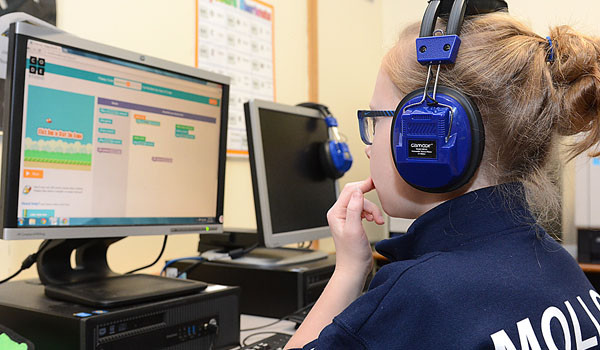Catholic schools engage students in 'Hour of Code'
by KIMBERLEE SABSHIN
The diocesan schools selected to pilot the STREAM initiative participated in an international program designed to encourage more children to become interested in the quickly growing field of computer science and also help prepare for careers.
From Dec. 8 until Dec. 12, students participated in an "Hour of Code" in their usual technology classes. Students became part of this initiative that Code.org, a non-profit organization dedicated to making computer science classes available in more schools, started last year. It also aims to encourage girls and minority students to participate in and secure jobs in a field that is in need of more diversity.
"One of the principles of STREAM is attention and focus on training and technology for both teachers and students," said Jean Comer, coordinator for the STREAM initiative in Catholic schools. "The Hour of Code, I learned about it last year through a gentleman who came in and was teaching my students when I was working at St. Gregory the Great in Williamsville. He does Internet advertising, so he (talked) about coding various programs for marketing. He asked us if we were doing the Hour of Code."
Code.org has enabled 60 million students to write more than three billion lines of code. It began as a YouTube video co-founders Ali and Hadi Partovi, twin brothers and computer programmers of Iranian descent, launched last year. It has grown to offer an introductory computer science course to three million students in 70,000 classes, with other lessons to help teachers in kindergarten through high school teach computer science classes. The courses have been translated into 30 different languages.
Comer said the Hour of Code is the largest learning event in history, and via Code.org, "anyone from six to 106 can go in and do beginning stages of coding." For children, it is layered in a play lab, where they can do coding with themes that will appeal to them based on their age, with "very familiar, relatable and fun activities" and basic steps. There is also a 20-hour course for all beginning computer programmers.
"This is kids' future. Their whole future in technology is related to coding, and this is the introduction to looking at the backside of any program - that it is coded. It's a language, and it's not that mysterious," Comer also said. "We think it is, so this is a global movement designed to introduce and demystify computer coding. For our students, this is going to be part of mainstream communication and development. With probably almost anything they're going to be doing, there is going to be a component of coding."
Code.org includes a wide variety of activities for both children and adults to learn how to code. Since the initiative focuses on appealing to girls and getting them involved with computer science at an early age, Wallace emphasized an application that uses characters from the Disney movie Frozen. With this program, users can direct a little girl to skate and create a pattern on the ice beneath her feet by choosing how many pixels they would like the character to move in a direction such as right, straight or left.
"You program it however you want, and you get to watch as this little skater goes around and makes the impressions in the ice. These kids are going nuts," Virginia Wallace, community relations coordinator for the diocesan Catholic Alumni Partnership, said. "It's an hour of code, but once they go through the training, they go home and they sit in front of their computer. Parents are now saying, 'Hey, what's going on here? My daughter came home and sat in front of the computer for three hours. I had to drag her away.'"
"I love that they picked Frozen, too," Comer commented. "Originally, when you think of IT, you think of males. There's this movement to get girls in any STEM fields, but in information technology, it makes it more appealing to girls to connect to, because if they can't connect and relate to how coding can be relevant in their lives now, they're not going to be interested in and move forward in it."
Wallace said the 10 pilot schools that participate in STREAM are learning how to "integrate across the curriculum," meaning that if one teacher is teaching ancient Greece in history, students will then go to an art class and learn about ancient Greek art. In a third class, they will learn about its religion. In Diocese of Buffalo schools, classes from kindergartners through eighth graders are participating. This method of teaching contrasts a method of learning where students learn about unrelated things in different classes.
"Computer programming and computer science, in general, is growing at two times the rate of any other job, and, in some states, at four times the rate. By 2020, there's a staggering statistic saying they will only just have enough people who have graduated with computer science degrees to fill the jobs," Wallace said. "Here we are, doing this with kids in elementary school. Some have four years of high school and four years of college (ahead of them), which will put them at the right time to have those prime jobs."




